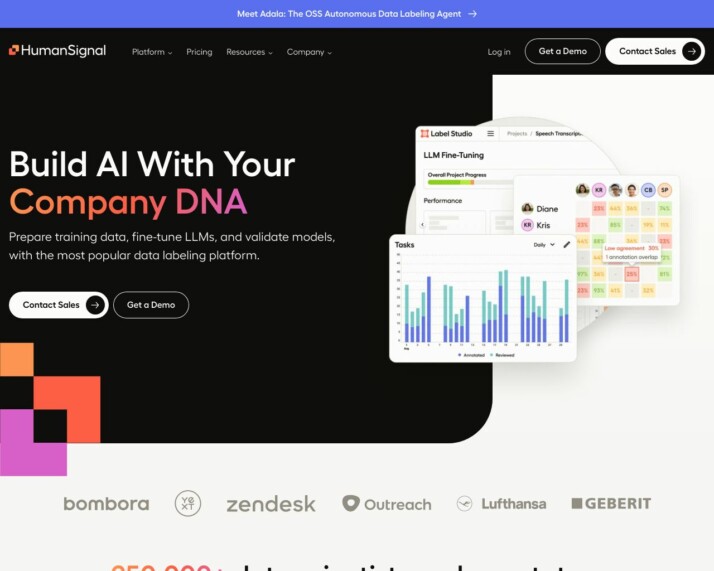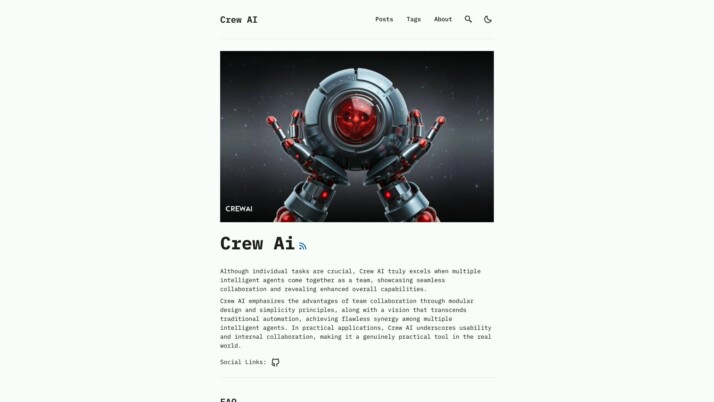In the rapidly evolving world of artificial intelligence, businesses and individuals alike are seeking powerful yet accessible solutions to harness the potential of this transformative technology. As we explore the capabilities of Adala vs. Crew AI, and SmythOS, we aim to provide a comprehensive understanding of their unique strengths and limitations, enabling readers to make informed decisions that align with their specific needs and requirements.
Whether you’re seeking autonomous data labeling agents, collaborative multi-agent systems, or a comprehensive AI platform, this comparison will shed light on the key features and functionalities that set these offerings apart.
Adala Overview
Adala is an open-source framework that enables developers to create autonomous data labeling agents. These agents leverage large language models like GPT-3 to learn and continuously improve their skills through interactions with data and human feedback.
Adala agents can acquire specialized skills such as text classification, summarization, and question answering by training on labeled datasets provided by users. The framework’s modular architecture allows for easy extensibility and community contributions, fostering a collaborative ecosystem for developing reliable and adaptable AI solutions.
One of the key strengths of Adala is its ability to combine the power of AI with human guidance. Agents can request feedback from humans on their predictions, creating a tight feedback loop that ensures high-quality results. This approach not only increases efficiency but also reduces the costs associated with data labeling tasks.


Adala’s vision is to provide a novel open-source platform for creating customizable autonomous agents specialized for data labeling and processing tasks. By abstracting low-level machine learning complexities, the framework empowers AI engineers, researchers, and data scientists to develop sophisticated AI solutions without delving deeply into the intricacies of machine learning algorithms.
Crew AI Overview
Crew AI is an intriguing open-source framework designed to facilitate the development of collaborative multi-agent AI systems. Its core capability revolves around enabling teams of specialized AI agents to work together seamlessly on complex tasks through structured workflows and processes.


At its heart, Crew AI provides developers with a Python library for configuring individual AI agents, defining their roles, goals, and backstories, and orchestrating their collaboration through configurable processes. This role-based agent architecture allows for intelligent task delegation, with agents autonomously handing off responsibilities or working together as needed.
A distinguishing aspect of Crew AI is its emphasis on human-in-the-loop integration, enabling agents to incorporate human input and feedback into their workflows.
Additionally, the framework’s process-driven approach ensures coordinated teamwork among agents, fostering a cohesive and efficient collaborative environment.
Feature Comparison
Adala and Crew AI are two distinct open-source frameworks designed for different purposes, resulting in notable differences in their feature sets and capabilities.
Adala is primarily focused on enabling the development of autonomous data labeling agents. Its core functionality revolves around leveraging large language models like GPT-3 to create agents capable of acquiring skills, such as text classification, summarization, and question answering, through interactions with data and human feedback. Adala’s agents are specialized for data processing tasks and can continuously improve their performance through a tight feedback loop with human guidance.
On the other hand, Crew AI is geared towards facilitating the development of collaborative multi-agent AI systems. Its primary strength lies in enabling teams of specialized AI agents to work together seamlessly on complex tasks through structured workflows and processes. Crew AI’s role-based agent architecture allows for intelligent task delegation, with agents autonomously handing off responsibilities or collaborating as needed.
While both frameworks are designed to enable the creation of AI agents, their focus areas differ significantly. Adala concentrates on autonomous data labeling agents, while Crew AI emphasizes multi-agent collaboration and coordination.
Adala’s agents are primarily focused on data processing tasks and can acquire specialized skills through learning from labeled datasets and human feedback. In contrast, Crew AI’s agents are designed to work together on complex tasks, with each agent potentially having a unique role and backstory. This role-based architecture facilitates seamless collaboration and task delegation among the agents.
Another key difference lies in the level of human involvement. Adala heavily relies on human input and feedback to guide and refine its agents’ performance, fostering a tight human-in-the-loop integration. Crew AI, on the other hand, places a stronger emphasis on enabling autonomous multi-agent collaboration, with agents coordinating their efforts without constant human intervention.
| Adala | Crew AI | SmythOS | |
|---|---|---|---|
| CORE FEATURES | |||
| Hosted Agents | ❌ | ✅ | ✅ |
| Visual Builder | ❌ | ✅ | ✅ |
| Autonomous Agents | ❌ | ✅ | ✅ |
| Work as Team | ❌ | ✅ | ✅ |
| Audit Logs for Analytics | ❌ | ✅ | ✅ |
| SECURITY | |||
| Data Encryption | ❌ | ✅ | ✅ |
| COMPONENTS | |||
| Zapier APIs | ❌ | ✅ | ✅ |
| All other APIs/RPA | ❌ | ✅ | ✅ |
| Logic | ❌ | ✅ | ✅ |
| DEPLOYMENT OPTIONS | |||
| Scalability | ❌ | ✅ | ✅ |
| DATA LAKE SUPPORT | |||
| TXT File Support | ✅ | ❌ | ✅ |
Best Alternative to Adala and Crew AI
While both Adala and Crew AI offer innovative approaches to building AI agents, SmythOS emerges as the superior alternative with its comprehensive feature set and versatility. SmythOS not only supports autonomous agents, visual builders, and team collaboration like Crew AI, but it also provides robust deployment options, scalability, and enhanced security features that outshine both frameworks.
Unlike the open-source nature of Adala and Crew AI, SmythOS is a commercial platform designed with enterprise-level capabilities in mind. It offers hosted environments for development and production, ensuring seamless deployment and management of AI agents. SmythOS prioritizes security with features like data encryption, OAuth support, and IP control, addressing a crucial aspect often overlooked in open-source solutions.
SmythOS excels in its extensive integration ecosystem, supporting a wide range of APIs, AI models (including OpenAI’s GPT and Hugging Face models), and tools like Zapier and RPA. This flexibility empowers users to create sophisticated AI workflows tailored to their specific needs, surpassing the more limited scope of Adala’s data labeling agents and Crew AI’s collaborative focus.
While Adala and Crew AI provide valuable frameworks for their respective domains, SmythOS stands out as the most comprehensive and adaptable solution for building and deploying AI agents across various industries and use cases.
Its rich feature set, robust security measures, and unparalleled deployment options make it the optimal choice for organizations seeking a powerful, scalable, and future-proof AI platform.
Conclusion
As we’ve explored the capabilities of Adala, Crew AI, and SmythOS, it’s evident that SmythOS stands out as the most comprehensive and versatile platform for building and deploying AI agents across a wide range of use cases. While Adala and Crew AI excel in their respective domains of autonomous data labeling and multi-agent collaboration, SmythOS offers a holistic solution that encompasses and extends far beyond these specific functionalities.
SmythOS empowers users to create, deploy, and manage AI agents with unparalleled ease and flexibility. Its intuitive drag-and-drop interface, coupled with a vast library of pre-built integrations and templates, enables businesses and individuals to harness the power of AI without extensive coding knowledge or technical expertise. From automating business processes and enhancing customer interactions to driving innovation and unlocking new avenues for growth, SmythOS provides the tools and resources to unlock the full potential of AI.
By supporting a wide range of AI models, including those from OpenAI, Anthropic, and Hugging Face, SmythOS ensures that users have access to the latest advancements in artificial intelligence, enabling them to stay at the forefront of innovation. The platform’s robust security features, such as data encryption, OAuth support, and IP control, provide peace of mind and ensure that sensitive data and intellectual property remain secure.
To learn more about how SmythOS can transform your business or workflow, visit the SmythOS deployment options page and explore the various deployment options available. From APIs and webhooks to chatbots and scheduled agents, SmythOS offers unparalleled flexibility and scalability, empowering you to integrate AI solutions seamlessly into your existing systems and processes. Don’t hesitate to contact our team for personalized guidance and support on your AI journey.
Last updated:
Disclaimer: The information presented in this article is for general informational purposes only and is provided as is. While we strive to keep the content up-to-date and accurate, we make no representations or warranties of any kind, express or implied, about the completeness, accuracy, reliability, suitability, or availability of the information contained in this article.
Any reliance you place on such information is strictly at your own risk. We reserve the right to make additions, deletions, or modifications to the contents of this article at any time without prior notice.
In no event will we be liable for any loss or damage including without limitation, indirect or consequential loss or damage, or any loss or damage whatsoever arising from loss of data, profits, or any other loss not specified herein arising out of, or in connection with, the use of this article.
Despite our best efforts, this article may contain oversights, errors, or omissions. If you notice any inaccuracies or have concerns about the content, please report them through our content feedback form. Your input helps us maintain the quality and reliability of our information.
Alexander De Ridder
Co-Founder, Visionary, and CTO at SmythOS. Alexander crafts AI tools and solutions for enterprises and the web. He is a smart creative, a builder of amazing things. He loves to study “how” and “why” humans and AI make decisions.
Explore All Comparison Articles
Decisions vs. Sola: AI Workflow Automation Showdown
AI-powered workflow automation platforms revolutionize how businesses streamline operations and boost productivity. This comparison explores Decisions vs. Sola, and SmythOS,…
DeepOpinion vs. Sola: Comparing AI Automation Platforms
AI-powered automation platforms revolutionize business operations, but choosing the right solution can be challenging. This comparison of DeepOpinion vs. Sola,…
DevGPT vs. Sola: AI-Powered Development Tools Compared
AI-powered development tools revolutionize software creation, offering unprecedented efficiency and capabilities. This comprehensive review compares DevGPT vs. Sola, and SmythOS,…
Fine AI vs. Sola: Comparing AI Automation Tools
AI-powered automation transforms software development and business workflows, offering unprecedented efficiency and innovation. Fine AI vs. Sola present distinct approaches…
FlowiseAI vs. Sola: Comparing AI Automation Platforms
AI-powered automation revolutionizes business operations, driving efficiency and innovation across industries. FlowiseAI vs. Sola offer distinct approaches to harness this…
Gooey AI vs. Sola: AI-Powered Automation Platforms Compared
AI-powered automation platforms revolutionize how businesses streamline operations and enhance productivity. This comparison delves into Gooey AI vs. Sola, two…

